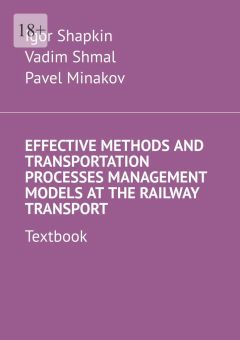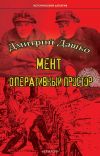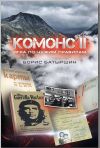Текст книги "Effective Methods and Transportation Processes Management Models at the Railway Transport. Textbook"

Автор книги: Igor Shapkin
Жанр: Прочая образовательная литература, Наука и Образование
Возрастные ограничения: +18
сообщить о неприемлемом содержимом
Текущая страница: 9 (всего у книги 11 страниц) [доступный отрывок для чтения: 2 страниц]
8.3 Digital technologies are the basis for railway operations efficiency increasing
The current stage of economic development has shown a global trend in the transition to digital technologies in almost all spheres of life. The need for integration and cooperation for profit growth and competitiveness, increasing internal efficiency and labor productivity have become the driving force for the transformation of industry, finance, telecommunications, public administration, services and, of course, transport.
The time-driven need to transform companies is ushering in an era of unprecedented change that digital opportunities can provide. The transformation of business and technological processes is not limited to the introduction of new digital technologies. Rather, technologies are used as a means of implementing transformations that go far beyond production activities and technological processes, should lead to a noticeable increase in the quality of work in the accepted performance indicators (KPIs) in comparison with previous periods, an increase in customer satisfaction, and an increase in labor productivity due to fundamentally new opportunities. Digital transformation depends on the organizational culture and work of individuals and, above all, managers, even more than on the implementation of technological solutions. The most difficult task in this case is to change the way people think. Managers must understand the essence, capabilities and competitive advantages of new technologies, adapt them to the needs of their departments and be the driving force for the implementation and resulting effect.
The reality is that industry leaders, natural monopolists who do not carry out active transformations, can very quickly lose market share, be left out of global integration processes within the framework of infrastructure, industrial and logistics projects using modern digital standards and progressive business processes. Large companies, which have long been industry leaders, must also innovate if they do not want to be replaced by the next successful startups, or become uncompetitive, «bottlenecks» in the world’s global business processes.
To move towards a more mature use of digital technologies, companies must remain focused on business transformation, making it a strategic and investment priority, as well as evaluate the effectiveness of measures aimed at transforming business and implementing digitally innovative technologies. As the analysis showed, companies that increased technology-related capital expenditures during the crisis were more likely to show above-average growth rates in the post-crisis period. Companies that reduced capital expenditures on technology during the crisis were more likely to show below-average growth rates in the post-crisis period. Companies also need to become more data-driven, analyze and use it more efficiently for management decision-making, scale up transformation, and embrace human resources.
Human resources, which are understood as qualified specialists and their skills and abilities, are an important problem that arises in the course of business transformation with the help of digital technologies. Qualified professionals and their skills, as well as company employees, play an important role as factors for the success of transformation; But a more significant role in this regard is assigned to the top management. One way to change the organizational culture in a company is to create an innovation lab to develop new technologies and gradually implement agile processes. Such a laboratory is equipped differently than the usual premises for everyday office work. Employees working in the laboratory are imbued with the ideas of flexible processes and revolutionary digital technologies. Returning to their usual duties, they gradually begin to change the organizational culture of the company. The company also aims to create a «digital aura» by recruiting digital transformation ideologues from other industries.
The impetus for digital-enabled transformation should be the results of production activities, expressed in specific volume indicators and KPIs. Studies and surveys of senior executives from around the world have shown that the main drivers of change are new business models, new technologies, the ability to innovate, revenue growth and cost reduction. The ability to innovate is the main criterion for assessing the success of digital-based transformations. Thus, the transformation of business using digital technologies is the highest priority task in the strategic plans of enterprises.
Russian Railways is actively involved in the process of transition to fundamentally new digital technologies, relying on modern IT solutions and regulatory documents that determine the strategic prospects for the technological development of railway transport in the world. These include the «Global Vision for the Development of Railway Transport» (GVRD, International Council for Railway Research, «Objectives-2050»). Vision of the railway sector and technical strategy for the development of the railway industry in Europe of the future».
Taking into account international experience, Russian Railways has put forward one of the most important priorities for the development of the industry the comprehensive introduction of digital formats into operational activities as part of the smart railway project in order to increase the efficiency, quality and speed of transportation, attract additional cargo volumes, increase labor productivity, increase revenues and reduce operating costs. This project is carried out in conjunction with the development of innovative energy and resource-efficient systems for rolling stock and infrastructure in order to obtain a common synergistic effect in all areas of activity of both the industry itself and the economy as a whole.
The main idea of the formation of a «digital railway» is the full integration of intelligent communication technologies between users of transport services (passenger, cargo owner, logistics company, rolling stock operator, etc.), vehicle, traffic management system and infrastructure.
The main principles of «digital technologies» of the organization of the transportation process are:
•non-discriminatory customer access to railway infrastructure;
• maximum use of electronic trading platforms in business practice;
• high level of automation of communication between customers, divisions of the Center for Corporate Transport Services and Transportation Control Centers;
• introduction of paperless technology (electronic document management) of interaction of all participants in the transportation process;
• customer-oriented, adaptive management of the transportation process;
• reliable door-to-door tracking system for the movement of goods, wagons, containers, real-time information about their actual and predicted location on the railway network of Russia and abroad;
• development and implementation of a unified intelligent system for managing and automating production processes in railway transport;
• development of fault-tolerant and cyber-attack-proof intelligent traffic and cargo/passenger traffic management systems, railway automation and communication systems harmonized with ERTMS standards;
• implementation of the concept of «smart locomotive» and «smart train», including the introduction of «autodriver» technologies that ensure a high level of train safety;
• implementation and regular audit of quality management systems covering the entire rail transportation system and its technological processes, as well as a number of other solutions.
Non-discriminatory access of customers to the railway infrastructure is provided on the basis of an integrated information and management system in the field of customer relations in the field of freight transportation using a CRM system, common information platforms and IT tools that ensure the exchange of information in real time between railway transport operators and other modes of transport, i.e. interaction between the external and internal control loops of the transportation process.
The electronic trading platform makes it possible to unite suppliers and consumers of transport and logistics services in one information and trade space, to ensure the provision of a number of services to participants in electronic trading platforms that increase the efficiency of their business.
Customer-oriented, adaptive management of the transportation process is implemented on the basis of software that allows to ensure the implementation of customer requirements in terms of route optimization, transportation speed, as well as a high degree of efficiency in the use of infrastructure and «firm» train schedules.
Electronic document management, in addition to the technological interaction of all participants in the transportation process in terms of transferring information, documents, management decisions, reports without the use of paper, also includes the preparation and prompt transfer of electronic train documents on board the locomotive with confirmation of their reliability.
Thus, «digital technologies» should create a full-fledged framework of automated business processes related to the transportation of goods and passengers by rail, based on the widespread use of modern software, technological and technical complexes, both directly in terms of the transportation process and in terms of interaction with customers and other modes of transport within the framework of global logistics chains.
The connecting role of all these elements and the final result in the form of transportation of a given volume and quality is played by the technology of operational work of railway transport. The whole range of activities (planning, development of regulatory technological documents, tactical and operational management, response to failures and failures in operational work and their elimination) is optimally organized, the management structure is optimally built, personnel are trained in the use of software and hardware, information technologies within the framework of their functional duties, analytical and reporting work is established, depends on the actual the effectiveness of all production activities of the railway industry, its contribution to the economy of the state.
To effectively solve the problems of managing operational work, it is impossible to be confined to solving individual small (but certainly locally important) issues without taking into account the interrelated processes of other business units. Despite the achievement of the effect in solving individual local problems, it can be leveled (or even make a negative contribution) at adjacent landfills or business units without the proper level of interaction between business processes, information systems and a balanced (at least consistent) system of quality indicators (KPIs) of different polygons and divisions. Managers and staff are required to have a deep understanding of their own processes and criteria for mutual influence on related units (landfills), the procedure for setting priorities in the flow of production tasks, signs of identifying operational situations that require control, the principles for the formation of indicators on which they make decisions, and on which they report on the work performed. Here it is fundamentally important to move away from parochial principles in management practice within the boundaries of their management polygons and their economic divisions.
Uncoordinated or unsystematic layering of the introduction of new technical and software-technological means without in-depth preparation and processing of detailed technology of work, as practice shows, does not lead in the vast majority of cases to a visible technological and financial effect, but only to a senseless expenditure of investments. At the current level of development of methods for managing the transportation process, planning and reporting, the existing information systems have significantly redundant information, while the initial information «from the field» about events in many cases is generated manually through messages, entering notes, etc., that is, it depends on the human factor. This has a negative impact on the quality of reporting and analytical information generated by numerous automated systems at all levels of management.
Each stage of the development of technology for the introduction of new technology should have a specific goal in the form of quantitative and qualitative indicators that must be achieved within a certain period. Monitoring and analysis of work after the implementation of the next stage of implementation should be carried out regularly, identifying positive effects and negative factors that impede the achievement of the set targets. Of course, there may be such implemented solutions for which it is difficult to directly calculate the technological or financial effect, but they significantly affect the usability of programs and hardware, the speed of decision-making, and the reduction of routine work. Such decisions, in the end, with the correct organization of the case, should lead to the effective work of personnel, the expansion of the area of responsibility of employees and the reduction of the overall need for personnel.
The direct technological effect is expressed in the acceleration of the transportation process, the reduction (minimization) of unproductive downtime, the reduction of the need for rolling stock and operational personnel, provided that the specified volume, quality and level of safety of transportation are ensured. Another important criterion is the high level of reliability of the transportation process itself (not earlier and no later than the specified delivery times, fulfillment of the schedule, etc.), the ability to prevent failures and failures, to ensure the flexibility of the use of resources and the rapid pace of their elimination for the transition to the normal mode according to the established technology.
Industry science and educational institutions, together with the production divisions of Russian Railways, should join forces for a detailed comprehensive analysis and transformation of control technology, taking into account the use of new technical and software and technological complexes, as well as for putting forward requirements for promising developments. The most important direction in research should be the construction of models and algorithms for the predictive development of situations and processes with various input parameters and influencing factors based on Big Data technologies, advanced business analytics, blockchain, artificial intelligence, the use of 3D models for studying situations at control facilities and training employees, voice control, augmented reality technologies. It is very important that these models and algorithms are of a specific application or research nature, have their own specific user and are used regularly for decision-making (of course, provided that the models give adequate results).
The process of teaching students, advanced training of engineers, managers and technical personnel, as well as the teachers themselves, should be conducted taking into account existing and future developments in all areas of professional activity, but at the same time should have a significant theoretical foundation of comprehensive knowledge in technical and organizational disciplines (management and business processes). The bias of education towards managerial disciplines to the detriment of technical and informational disciplines can subsequently lead employees to an incorrect perception of the situation and the formation of management decisions, including in terms of planning and operational management, due to a lack of understanding of the physics of processes and the time frame necessary for this and the possible level of productivity and the resulting performance indicators.
Therefore, in the practice of education and advanced training, it is necessary to introduce educational versions of the implemented automated systems and technical means on the basis of educational laboratory test sites. This will give an additional impetus to new ideas for improving systems, on the one hand, and increasing the level of practical training.
The most important point is the development and dissemination among students and employees of a single and standardized conceptual apparatus for definitions and terms (without common words and logical contradictions), uniform standards for mathematical calculations of indicators, data sources, a set of conditions and restrictions for calculation.
Practice shows that there are significant differences in the interpretation of concepts among managers and personnel of different divisions and branches of Russian Railways, as well as different approaches to calculating indicators identical in name (of course, with different results compared to the classical rules). Similar discrepancies also occur in automated systems, when essentially the same indicators are calculated in different ways, reporting and statistics are distorted and, accordingly, negatively affect decision-making. Since the total number of different indicators, taking into account the large number of objects of control and the emergence of new aggregations of objects into enlarged polygons, types of calculations of indicators (per day, at the moment, increasing from the beginning of the month, average daily from the beginning of the month) is constantly increasing, the lack of uniform clear rules for calculating indicators (especially those that are calculated using mathematical formulas and do not have an additive property!), turns calculation and analysis into a complex problem and leads to discrepancies in different automated systems.
The separation of vertically integrated structures with their own scorecards and a system for delineating responsibility for technical failures and technological violations between departments (through the KASAT and KASANT systems, operational dialogue modules of various automated systems for the appointment of responsible services and reasons from classifiers) led to negative aspects, such as:
• weakening of horizontal technological ties at all levels,
• weakening the consolidating role of local leaders,
• manifestation of parochial interests of individual services (units) to the detriment of operational work.
Nevertheless, through digital technologies, new hardware and software, and the transformation of management methods, it is possible to significantly raise the level of quality of operational work and the entire production complex of Russian Railways.
Next, we will consider the main possibilities of using digital technologies and their impact on performance indicators, such as wagon turnover, delivery speed, and wagon downtime at stations.
It can be concluded that in order to reduce the downtime of cars at stations, increase the speed of train passing, it is necessary to strengthen the management role of stations, regional transportation control centers, the transportation control center of Russian Railways as a coordinating management body, as well as significantly strengthen the operational interaction of the vertical of traffic control, traction, infrastructure, with recipients and port stations.
To do this, it is necessary to significantly modernize business processes and software and hardware systems at all levels of management to minimize inter-operational downtime downtime, ensure clear interaction between station parks, stations and sections, interacting dispatch areas, control areas and regional directorates.
Software and hardware systems should not only provide a wide range of information materials from operational and reporting systems (in tabular and graphical form), but also give understanding to dispatchers and managers of understanding and hints about current and possible difficulties based on process modeling tasks. The formation of control actions on the basis of machine analysis of situations, calculated options for solving failure situations and difficulties should be carried out in the form of a system of electronic control orders issued by participants in management processes from the initiator to the executor through automated workplaces. The first stage of tasks for the formation of control orders is implemented as part of the Information and Management System of the Transportation Control Center.
For interactive data analysis, it is necessary to introduce business intelligence software tools into wide practice, which allows interactively and visually to carry out deeper data analysis, determine the mutual influence of events and indicators on each other to improve and accelerate the planning and operational management process.
To understand the current position at stations, you can use the functions of representing parks and tracks on a 3D model of the station diagram with reference to actual data on trains, locomotives, crews, tracks from operational and infrastructure models. It is also effective to consider the possibility of issuing images from video cameras at stations in the workstation or on a collective display with augmented reality technology with the binding of recognized objects to the terrain and the issuance of information about them over the video image, for example, data on locomotives on the tracks of station parks from a camera installed in the neck on the mast.
A useful function for dispatchers of the traffic control vertical is current information about the speeds of a group of trains at stations and sections of the dispatching area, existing malfunctions of locomotives (based on information from the onboard devices of the locomotive), especially with a complex track profile.
Information on the rating of reliability and versatility of locomotive crews and locomotives in the areas of planning for marshalling yards is extremely relevant. It often turns out that with the general availability of locomotives and crews at the station, they cannot be used specifically for the removal of existing and planned trains due to restrictions on run-in sections (versatility rating).
The use of 3D models of stations and sections can also help in familiarizing locomotive crews with new break-in sections to improve their versatility rating. These models can also be useful to the dispatching apparatus when learning to work in new areas (or in the case of reconfiguration of sections).
The reliability rating of locomotives and crews is calculated on the basis of historical data on unscheduled repairs, failures, etc. incidents with a specific object. It also assesses the residual mileage or time of the locomotive and crew with the provision of possible options for action or possible stations to which they can reach without violations, which is a criterion for decision-making in the current planning of the departure of trains, locomotives and crews on the lines of the schedule.
In general, modern digital technologies can, subject to changes in management technologies, improve the quality of operational work, reduce unproductive downtime, increase speeds by improving the level of interaction with each other and awareness of participants about the available priorities, approaches and planned resources for the implementation of plans and operational tasks.









































